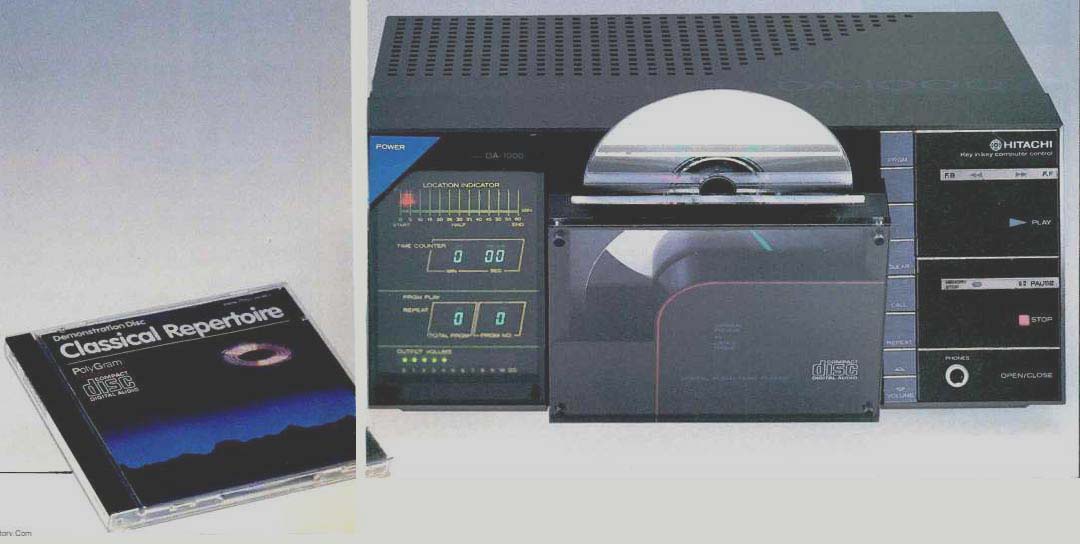
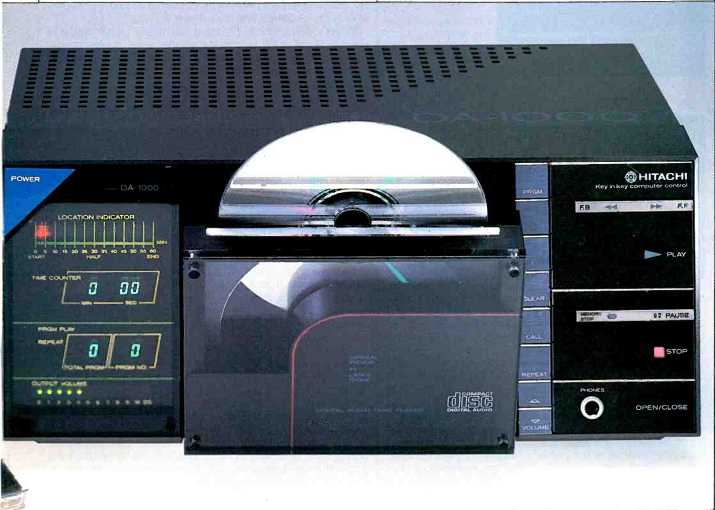
Manufacturer's Specifications
Frequency Response: 20 Hz to 20 kHz, ±0.5 dB.
Dynamic Range: More than 90 dB.
S/N Ratio: More than 90 dB.
Channel Separation: More than 60 dB.
Distortion: 0.03%.
Wow and Flutter: Not measurable.
Line Output Level: 1.4 volts for 0-dB record level.
Power Consumption: 24 watts.
Dimensions: 12.6 in. (32 cm) W x 5.7 (14.5 cm) H x 9.2 in. (23.4 cm) D.
Weight: 12.32 lbs. (5.54 kg).
Price: Not determined.
Company Address: 401 West Artesia Blvd., Compton, Cal. 90220.
I must confess that when I was asked to test and evaluate a second digital audio disc player only a few weeks after having tested the Sony CDP-101 (for the November 1982 issue of Audio, with a follow-up elsewhere in this issue), I suspected that the project would result in identical measurements and even identical product descriptions. Nothing could have been further from the truth. I am happy to inform my colleagues who test and evaluate audio products that their futures are secure. Digital audio players are not all peas in a pod. They are, in fact, as different from each other as are analog audio products. As it turns out, these first two DAD players differ not only in features and physical configuration, but in measured performance characteristics as well.
If I had to sum up my conclusions about each, I'd say that the Hitachi has the edge on convenience features, but not as far as pure, measured performance is concerned.
The Hitachi DA-1000 is configured somewhat like a cassette deck, in that digital discs are loaded into the machine via a swing-down door. A slot at the top of this door accepts the disc, which should be inserted with its label facing you.
Slight downward pressure on the disc itself activates a motor mechanism which both "swallows" the disc and closes the hinged door. With no further directions from the user, the disc (which is now upright, its label towards the user) then spins briefly so that the laser pickup can read the disc's coded "Table of Contents." The left section of the panel is dedicated to several illuminated displays and to the power on/off switch. One of these displays tells the number of individual selections on the disc, as well as the number of the selection currently being played. Thus, a few seconds after the measurement test record is inserted in the machine, this display tells us that there are 39 separate "bands" or selections on the record, as indeed there are. (See my description of the test disc in the Sony CDP-101 "Equipment Profile" postscript in this issue.) Another display, below the "Program/Play" display, indicates volume level supplied to the phone jack and to the variable-level output jacks at the rear of the unit. A real-time counter display indicates elapsed time since the beginning of the selection being played or, during programming of the desired selection, the total time of the selections being called for. Still another display, the "Location Indicator," shows how far into the disc you are, using a moving-LED spot on a scale calibrated in five-minute increments from 0 to 60 minutes (the approximate total playing time per side of a DAD disc). The right-hand portion of the DA-1000's front panel contains buttons for programming, volume "Up" and "Down," play, stop, and door open/close as well as a stereo phone jack. In addition, there are two rocker bars in this area, one of which handles fast-forward/fast-replay functions, the other pause and "Memory Stop." These last-named functions are so versatile that it was necessary to read the preliminary English translation of the owner's manual to understand all of the functions they perform. Take the fast-forward/fast-backward button, for example: When fast-forward is pressed, the laser pickup advances only to the beginning of the next selection and then begins to play it. Depressing fast-backwards once brings the pickup back to the start of the selection currently being heard, while depressing it a second time moves the pickup back to the start of the previous selection. In this, it is less like a tape recorder's fast-forward and fast-rewind than like a cassette deck's auto search function.
The remaining controls are for programming and volume adjustment. Random-access programming is accomplished by depressing the "Program" touch button, followed by the number of the selection you want to hear first; this process is repeated until you have programmed all preferences in desired order. To make programming a little less tedious, touch buttons labeled "1" and "10" are provided. Thus, if you want to hear selection number 22, you would touch the "10" button two times and the "1" button twice; the number "22" will then appear in the indicator at the left end of the panel. A "Clear" button erases previous programming and a "Call" button permits you to see on the display what you've programmed. A "Repeat" button, if depressed when there is no preprogramming entered, will simply cause the disc to be played over again. If it is depressed when a random-access program has been entered, it will cause repeat play of only those bands that have been selected.
When in stop mode, pressing the "Call" button displays the play time of all selections on the disc. In play mode, pressing "Call" displays the play time from the start of the disc to the current play position. With so many displays and indications available (I've probably left some out) and so much information to be gathered about each disc, one wonders when the user will have time to listen to some music! The rear panel of the DA-1000 is much more simply configured. It is equipped only with a pair of fixed output jacks and a pair of variable output jacks whose output signal level, like that of the headphone jack, is controlled by the volume control buttons.
Measurements
I subjected the Hitachi DA-1000 player to all the tests on the Sony test disc. Frequency response was almost ruler-flat, as shown in Fig. 1, though there was a fraction of a dB of rise at around 16 Hz and a dip amounting to just short of 1 dB at 20 kHz. These slight deviations from perfectly flat response would seem to indicate that the anti-aliasing, sharp cutoff filter in this particular sample may not have been optimally tuned, but the deviations are certainly negligible from a listener's point of view.
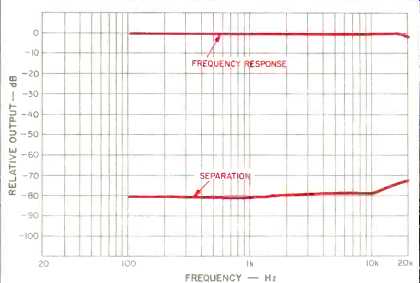
Fig. 1--Frequency response and channel separation.
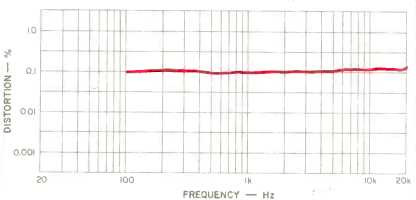
Fig. 2--Distortion vs. frequency.
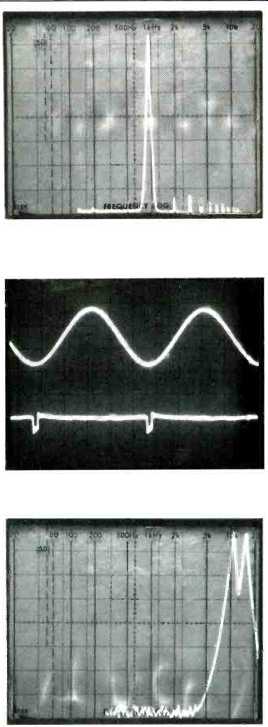
Fig. 3--THD analysis of a 1-kHz test signal.
Fig. 4--Distortion components (lower trace) during playback of high-level 1-kHz test signal; the output signal is represented by the upper trace.
Fig. 5--Twin-tone IM measurement discloses no visible IM components, but noise level is within dynamic range of the spectrum analyzer display.
Separation, though superb (and 20 dB better than Hitachi specifies), was not as high as the other player's. It hovered around the 80 dB level, decreasing to just over 70 dB at the 20-kHz test frequency. This still exceeds the modest claim of 60 dB made by Hitachi and surpasses by far anything that has yet been achieved with an analog disc or tape.
Total harmonic distortion at 0 dB (maximum output) level for this unit was considerably higher than I measured for the Sony player and was, in fact, considerably higher than the 0.03% claimed by Hitachi. A graphic plot of harmonic distortion versus frequency, using the test frequencies available on the test record, is shown in Fig. 2.
I was somewhat perplexed by this relatively high (though audibly insignificant) THD level, the more so because the competing unit had exhibited distortion levels that were at least an order of magnitude lower. Applying the 1-kHz test signal (at 0 dB) to spectral analysis, I confirmed that the problem was, indeed, common garden-variety THD and not noise or other non-harmonically related residual signals, as can be seen in Fig. 3. To the right of the desired 1-kHz "spike" we see a rather large number of harmonic components, all the way up to a tenth harmonic. Higher order components may also be present but may be too low in level to be discerned with this spectrum analyzer's limited 80 dB of dynamic range. Investigating further, I checked the output waveform and the distortion component waveform (as derived from a distortion analyzer) on a dual-trace 'scope, Fig. 4. The lower trace shows the distortion components found in the output signal, which is depicted by the upper trace. The problem looks almost the same as clipping, so I suspected that perhaps what Sony considers to be "0 dB level" might be higher than that for the Hitachi unit.
I therefore repeated the distortion measurements at a-10 dB signal level, which is also available on the test disc.
Distortion remained virtually the same: 0.1%. SMPTE IM, also measured using the same test disc, was 0.06% at 0 dB level and 0.16% at-10 dB recording level. If there were any IM components generated by the twin-tone (19 and 20 kHz) test signals, they remained buried beneath the noise floor observable in the spectrum analyzer display of Fig. 5.
As for that noise floor, I measured it as being 83 dB below reference maximum output level when no weighting was applied and as 87 dB below when using an A-weighted network. This falls somewhat short of the 90 dB of dynamic range claimed for the DA-1000, but again, it is around 20 to 25 dB better than the dynamic range available from even the best analog LP records.
De-emphasis built into the DA-1000 was within around 0.2 dB of the values required, judging from the three available test frequencies on the test disc. While precise readings of -0.37, -4.53 and -9.04 dB are prescribed at 1, 5 and 10 kHz, I measured attenuations of -0.4, -4.8, and -8.8 dB at those frequencies respectively.
Use and Listening Tests
In my first tests of a digital audio disc player, most of the musical listening was confined to Polygram DADs. For testing the Hitachi DA-1000, I was also able to add a CBS-Sony DAD release to the collection. The new disc, cataloged as 38DC 1, is a recording of Beethoven's Fifth Symphony plus Schubert's Eighth ("Unfinished") Symphony, both conducted by Lorin Maazel with the Vienna Philharmonic Orchestra.
Of interest was its price, printed right on the back page of the little pamphlet packaged with the disc. (It's legal in Japan for manufacturers to set retail prices for their wares, though retailers can still discount those prices if they like, and many do.) The price read 3800 yen which, when converted at a rate of around 260 yen to the dollar (current rate as this is being written), works out to $14.62. Not bad for an "audiophile" record such as this, wouldn't you say? Although most of the information contained in the pamphlet is in Japanese, the recording data section is in English and indicates that the Beethoven was recorded in Nagoya, Japan on November 5, 1980, and the Schubert work about a week later, on November 13, 1980, at Hitomi Memorial Hall in Tokyo. I mention this only to convey the important fact that these were live recordings mastered digitally, and not simply re-recordings of analog master tapes in digital format.
Though the Hitachi DA-1000's measurements were no match for the other player's, its sound quality when playing discs was superb. It is hard to correlate musical loudness levels with single test-tone levels, but it did seem to me that the test record tended to push things a bit, and that most of the musical discs I played had peak levels recorded at somewhat lower absolute levels. I do not know whether this was done deliberately to prevent accidental over-recording (a veritable catastrophe in the case of digital records) or is simply a random thing.
From time to time, the Hitachi DA-1000 did not respond correctly to my programming commands when I tried to program sequential bands on the test record in a particular order. In one case the laser pickup began playing the wrong selection; in several other cases, especially when I called for a high-numbered selection, the player began to spin the disc, seemed to search for the required band, and then gave up and stopped. It may well be this was because the test record had so many (39) separate "selections." The failure to program correctly never occurred with any of the musical records which I played on the machine.
All of this in no way detracts from the excellent quality of music reproduction which I heard and which was virtually indistinguishable from the quality of sound obtained from the Sony unit. I get the feeling that Hitachi's engineers concentrated more on displays and front-panel features. If that doesn't add anything to the price, fine. But if the DA-1000 ends up costing significantly more than the competition without sounding better (and in fact, measuring somewhat poorer), then it is up to the individual as to whether the bells and whistles are worth the extra money.
-Leonard Feldman
Editor's Note: This DA-1000 was a late pre-production unit, built by hand instead of on the line, and its measurements may possibly not be up to those of actual production samples. We will test a production unit as soon as possible, and will report on any differences we find. -E.P.
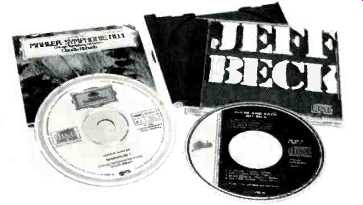
Two recent Compact Disc releases.
=================
(Source: Audio magazine, Jan. 1983)
Also see:
Hitachi DA-600 Compact Disc Player (Feb. 1985)
= = = =